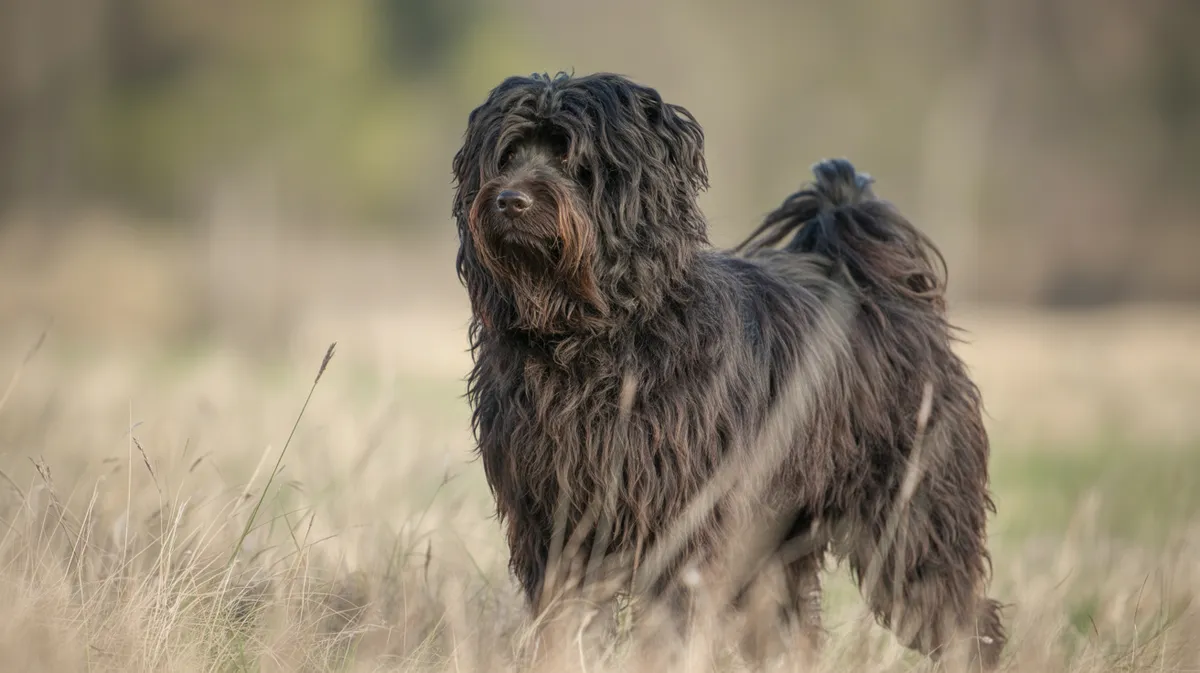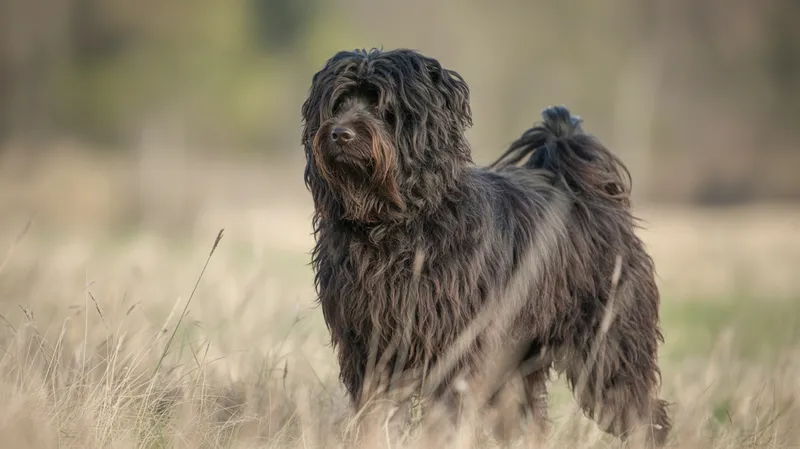
Puli Dog
Canis lupus familiaris

Meet the Puli Dog
The Puli is a distinctive Hungarian herding dog breed known for its long, corded coat that resembles dreadlocks. Originally bred to herd sheep in the Hungarian plains, the Puli is agile, energetic, and highly intelligent. Its unique waterproof coat protects it from harsh weather and predators, while its lively temperament makes it an excellent companion animal. The Puli is renowned for its loyalty, quick reflexes, and strong herding instinct, making it both a devoted family pet and an efficient working dog.
Classification
Mammal
Habitat
Domestic; originally Hungarian grasslands (Puszta)
Diet
Omnivore
Lifespan
10-15 years
Conservation
Least Concern
Weight
10-15 kg (22-33 lbs)
📖Fascinating Facts
Naturally Corded Coat
The Puli’s signature mop-like coat forms cords on its own, providing insulation and protection from rough weather and predators.
Expert Herding Dog
Pulik have been used for centuries in Hungary to herd sheep and other livestock, prized for their intelligence and agility.
Agility Champion
Despite their unusual appearance, Pulis are remarkably agile and frequently excel in dog agility sports and competitions.
📋Detailed Description
The Puli is a medium-sized herding dog, typically standing 36–45 cm (14–18 inches) at the shoulder and weighing between 10–15 kg (22–33 lbs). Its most distinctive feature is its dense, long, corded coat, which naturally forms tight, woolly cords resembling dreadlocks by the age of 1–2 years. This coat is double-layered, with a soft undercoat and a coarser outer coat, providing exceptional insulation and waterproofing—adaptations for the harsh climates of the Hungarian plains. The Puli has a compact, muscular build, with a slightly arched back and a tail that curls tightly over its back. Its head is round with a pronounced stop, dark almond-shaped eyes, and medium-sized, pendant ears. Highly agile and energetic, the Puli is renowned for its quick reflexes and ability to change direction rapidly, essential traits for herding livestock. The breed is highly intelligent, displaying problem-solving abilities and a strong desire to work closely with humans. Socially, the Puli is affectionate and forms strong bonds with its family, often displaying protective instincts. Its vocalizations are varied, and it is known to be an alert watchdog. The breed is long-lived, with an average lifespan of 12–16 years, and generally enjoys robust health when properly cared for.
💡 Did you know?
Did you know that Pulik (plural for Puli) were so valued by Hungarian shepherds that they often cost as much as a year’s wages?
🔬Research & Sources
🎭Behavior & Social Structure
Pulis are highly active and require significant mental and physical stimulation. Historically, they worked in close partnership with shepherds, using their agility and intelligence to control and direct sheep, often working independently at great distances from humans. They employ a distinctive herding style, circling and darting to keep livestock together. Pulis are known for their playful, sometimes mischievous nature, and they thrive on interactive games and tasks. They are naturally wary of strangers, making them excellent watchdogs, but are typically gentle and affectionate with their family. Socialization is important to prevent excessive shyness or territoriality. Feeding behavior is typical of domestic dogs, with a preference for high-quality, balanced diets; they may display food-guarding tendencies if not properly trained. Daily routines should include vigorous exercise, problem-solving activities, and regular grooming to maintain their unique coat.
👶Reproduction & Life Cycle
Pulis reach sexual maturity around 8–12 months of age, though responsible breeding is recommended after 18 months. The breed exhibits typical canine mating behavior, with estrus cycles occurring twice a year in females. Gestation lasts approximately 63 days. Litter sizes range from 4 to 8 puppies, with neonates born blind and deaf, relying entirely on maternal care. Puli mothers are attentive, providing warmth, grooming, and protection. Puppies begin to open their eyes at 10–14 days and are weaned by 6–8 weeks. Early socialization and exposure to various stimuli are crucial for healthy behavioral development. Breeding seasonality is not pronounced in domestic settings, though historically, spring and autumn were preferred for optimal survival conditions.
🛡️Adaptations & Survival
The Puli’s corded coat is its most significant adaptation, offering protection against extreme weather, water, and even predator bites. The coat’s structure allows it to shed dirt and debris easily, a vital trait for a working dog in open fields. Its compact, agile body and strong hindquarters enable rapid acceleration and sharp turns, essential for herding. The breed’s acute senses—especially hearing and sight—are finely tuned for detecting movement and potential threats. Behaviorally, the Puli’s intelligence and trainability are evolutionary advantages, allowing it to adapt to complex tasks and changing environments. Its strong social bonds and protective instincts have been reinforced through generations of selective breeding for companionship and utility.
📚Research Sources
🎨Cultural Significance
The Puli holds a revered place in Hungarian culture, symbolizing pastoral heritage and national pride. It has been depicted in Hungarian folklore, literature, and art for centuries, often associated with shepherds and rural life. The breed’s intelligence and loyalty have made it a favorite among Hungarian nobility and commoners alike. In modern times, the Puli has gained international recognition, with notable owners including celebrities and public figures. Its unique appearance has made it a popular subject in media and advertising. The Puli is also celebrated annually at dog shows and cultural festivals in Hungary, where it serves as a living emblem of the country’s agricultural traditions.
🔬Recent Research & Discoveries
Recent genetic studies have explored the Puli’s relationship to other Hungarian herding breeds, such as the Komondor and Mudi, revealing a shared ancestry and unique adaptations to the Pannonian steppe environment. Ongoing research focuses on the genetics of coat formation, particularly the mechanisms behind cord development and maintenance. Behavioral studies have highlighted the Puli’s advanced problem-solving skills and social intelligence, making it a model for canine cognition research. Veterinary research continues to monitor breed-specific health issues, with efforts to map hereditary conditions and promote genetic screening. Conservationists and breed clubs are collaborating internationally to maintain genetic diversity and preserve traditional working traits.
🎥Wildlife Videos

Cubs Meet Adult Tiger for the First Time | Tigers About The House | BBC Earth
As the cubs grow up Giles Clark thinks it's time for Spot and Stripe to start socialising with the adult tigers. Taken from Tigers About ...
BBC Earth

Cheetahs Takedown a Wildebeest | The Way of the Cheetah
Five cheetah siblings join together and takedown an adult wildebeest. ➡ Subscribe: http://bit.ly/NatGeoWILDSubscribe ...
Nat Geo Animals

Wildlife HD Animals | Pet and Animals | Calm Music | Animals HD Videos | Love and Care | #Puliveeran
Thanks for watching....
Puliveeran

Most Amazing Big Cats Hunting Attack Compilation Cheetah Lions Jaguar Leopard
This clip features some of the most incredible Big Cats Hunting attacks compilations including cheetahs hunting, loins, tiger, ...
Visual Tv

Leopard Jumps on The Tree to Attack Monkey - Fierce Battle of Baboon in India | Snake vs Lizard
Leopard Jumps on The Tree to Attack Monkey - Fierce Battle of Baboon in India | Snake vs Lizard. Welcome to Africa Wild Animals ...
Africa Wild Animals
🌍Habitat Information
The Puli Dog typically inhabits Domestic; originally Hungarian grasslands (Puszta) environments. Puli Dogs have adapted to their environments with specialized features and behaviors.
Primary Habitat:
Domestic; originally Hungarian grasslands (Puszta)
More detailed habitat information will be available soon.
🛡️Conservation Status
The Puli Dog is currently classified as Least Concern. Conservation efforts are crucial for preserving this species for future generations.
Common Threats:
- 🏠Habitat loss and fragmentation
- 🌡️Climate change impacts
- 🎯Hunting and poaching
- 🏭Human-wildlife conflict
⚠️Threats & Conservation Challenges
While the Puli is not at risk of extinction and is classified as 'Least Concern,' the breed faces challenges related to genetic diversity due to its relatively small global population. Modern lifestyle changes and reduced demand for traditional herding dogs have led to a decline in working lines, with many Pulis now bred primarily for companionship. This shift can result in the loss of herding instincts and working abilities. Health challenges include a predisposition to hip dysplasia, progressive retinal atrophy, and some autoimmune disorders, though responsible breeding practices can mitigate these risks. Grooming neglect can lead to skin infections and matting. Human impact is mostly positive, with breed enthusiasts and clubs actively promoting conservation and responsible ownership.
🔬Scientific Classification
Scientific Name
Canis lupus familiaris
Classification Hierarchy
🔍 About Taxonomic Classification
Taxonomic classification is a hierarchical system used by scientists to classify and organize living organisms based on shared characteristics and evolutionary relationships.
The system moves from broad categories (Kingdom) to increasingly specific ones, with each animal's scientific name typically consisting of its Genus and species.
📝Community Notes
Share your observations and insights about the Puli Dog with our community of wildlife enthusiasts.
Join Our Community
Sign in to share your observations and connect with fellow wildlife enthusiasts.
Sign In to ContributeNo community notes yet
Be the first to share your observations about the Puli Dog!
Explore Puli Dog
Select a tab above to learn more about this amazing animal.
📸Photo Gallery
No photos available for this animal yet.
🌟Discover More Wildlife
Continue your journey of discovery with more fascinating animals from our database
